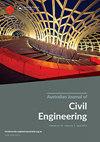Effect of polymers and micro fibres on the thermo-chemical and rheological properties of polymer modified binders
IF 1.6
Q3 ENGINEERING, CIVIL
引用次数: 6
Abstract
ABSTRACT Polymer-modified bitumen provides superior thermo-chemical and rheological properties. This study focuses on the correlation between the thermo-chemical and rheological characteristics of bitumen modified with five different polymers in addition to neat bitumen. The polymers include an amine-wax-based additive, thermoplastic elastomers, a system of elastomers and microfibres, plastomers and a system of plastomers and microfibres. The chemical compositions were investigated using Fourier-transform infrared spectroscopy (FTIR), while the thermal behaviour was studied using differential scanning calorimetry (DSC) and thermogravimetric analysis (TGA). The modified bitumen’s rheological performance was analysed using frequency sweep, linear amplitude sweep (LAS), and multiple stress creep and recovery (MSCR) tests. Rheological properties showed that the combination of fibre and polymers improved the thermal susceptibility of the bitumen at all ranges of temperature compared to other blends that only included single polymers. FTIR spectroscopy suggests that the polymer modification resulted in successful blending and active cohesion between the polymer matrix and bitumen. TG/DTG analysis confirmed that the modified blends exhibited greater thermal stability than neat bitumen. Glass transition temperature (Tg) was obtained from DSC to predict the polymers’ low-temperature rheological properties whereas, degree of crystallinity and melting point showed the intermediate and high temperature properties of the binders.聚合物和微纤维对聚合物改性粘结剂热化学和流变性能的影响
摘要聚合物改性沥青具有优异的热化学和流变性能。本研究的重点是用五种不同的聚合物和纯沥青改性沥青的热化学和流变特性之间的相关性。聚合物包括胺蜡基添加剂、热塑性弹性体、弹性体和微纤维系统、塑性体和塑性体与微纤维系统。使用傅立叶变换红外光谱(FTIR)研究了化学成分,同时使用差示扫描量热法(DSC)和热重分析(TGA)研究了热行为。通过频率扫描、线性振幅扫描(LAS)和多次应力蠕变和恢复(MSCR)试验分析了改性沥青的流变性能。流变性能表明,与仅包含单一聚合物的其他共混物相比,纤维和聚合物的组合提高了沥青在所有温度范围内的热敏感性。FTIR光谱表明,聚合物改性使聚合物基体与沥青成功共混并具有活性内聚力。TG/DTG分析证实,改性的共混物比纯沥青表现出更大的热稳定性。通过DSC获得玻璃化转变温度(Tg)来预测聚合物的低温流变性能,而结晶度和熔点显示了粘合剂的中高温性能。
本文章由计算机程序翻译,如有差异,请以英文原文为准。
求助全文
约1分钟内获得全文
求助全文

 求助内容:
求助内容: 应助结果提醒方式:
应助结果提醒方式:


